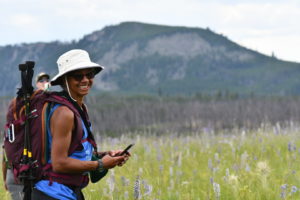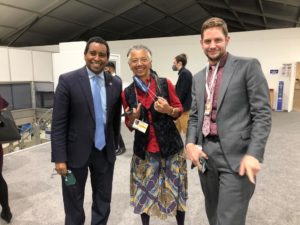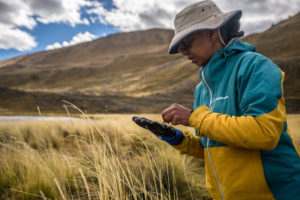
In honor of Women’s History Month, celebrated annually in the month of March, we highlight women in the Warner College of Natural Resources who are making change to create opportunity, invite and celebrate diversity and lend their voices to the natural resources fields.

Gillian Bowser is an associate professor in the department of Ecosystem Science and Sustainability in the Warner College of Natural Resources at Colorado State University. She also works as a research scientist at the Natural resource Ecology Lab.
Bowser’s research focuses on the protection of biodiversity and nature’s resources and the access of such resources to everyone. Her research group works mainly on pollinators in high-elevation parks like Yellowstone, Grand Teton and Yosemite National Parks.
Bowser has worked throughout her career to elevate the voice of CSU students to international platforms. Recently, Bowser led a group of CSU students to Glasgow in Scotland for the 2021 United Nations Climate Change Conference. Known as the COP, or Conference of the Parties, the event marked the 26th time that people from around the world will meet to ensure more money is spent on climate action and how to support developing countries investing in green technologies.
Q&A with Gillian Bowser
Can you share with us a career highlight?
My career highlight was being selected to be an American Associate for the Advancement of Science Science Diplomacy Fellow at the U.S. Department of State. I served in the division of Oceans, Environment and Science Office of Marine Conservation working on fish treaties. OMC is one of the most dynamic offices in the Department of State that most people have never heard of but have benefited from through every deep sea or aquaculture raised fish that enters the United States.
I was fortunate to work on a wide variety of fish treaties (Marine Mammals are under a separate office) from tuna to salmon. All of the treaties work with international partners and in the case of salmon, Alaska tribes and Canadian First Nations. One highlight of that experience was to be in Kazan Russia sitting at a table with delegates from all over the world and with many fishery scientists learning about deep sea mounts, turtle excluder devices and the challenges of separating out shark species in the field.
Do you have any women who have inspired you or mentored you in your NR career? If so, who? What was their influence?
My first female mentor was Dr. Mary Meagher, the bison ecologist for Yellowstone National Park and one of the first female scientists employed by the National Park Service. She worked for decades on bison behaviors living the entire summers in a remote cabin on the Blacktail Deer Plateau section of the park. Her patience in recording details of bison behavior and modeling their behaviors taught me the importance of simple observations as critical stepping stones in understanding ecosystem processes.
Ironically, she was the one that encouraged me to first look at butterflies within Yellowstone. She told me that I should choose something that no one else had touched within the park and make that topic my own. ‘No one,’ she said, ‘pays attention to the small stuff like butterflies and pollinators.’ Decades later, I still study these small things and my own graduate student works on the same site that Dr. Meagher introduced me to on the western side of the park–because she thought it was unique for the intense flower blossoms across a wide meadow completely hidden from public view.

What advice do you have for women entering this field?
Ecology has shifted towards a fast-paced field of fancy models mostly done with limited field time and with a lot of screen time, yet our ecosystem details remain un-observed and learning the patience of simple observations to tell simple stories is so important. The public connects to stories and our national parks are in danger from external forces such as changing climate conditions and invasive species. What is the story of the bumble bees within Grand Teton National Park? Where are the fritillaries in Yellowstone National Park? These stories about the parks and their residences are what the public needs to hear.
As the public is becoming increasingly culturally diverse, who tells those stories and how they are told matters more now than ever. Whether the decline of populations, the shifting of species ranges or the introduction of new species like the honeybees (that now appear in national parks as wild populations), the public cares about our national parks so helping tell the stories of all the organisms that are critical to the ecosystem processes within a protected area is critically needed.